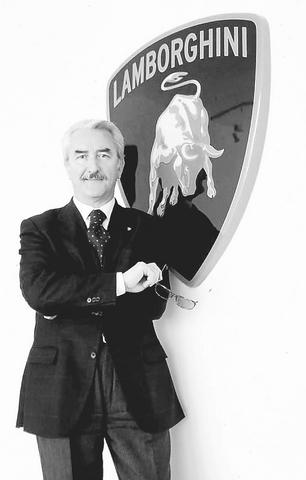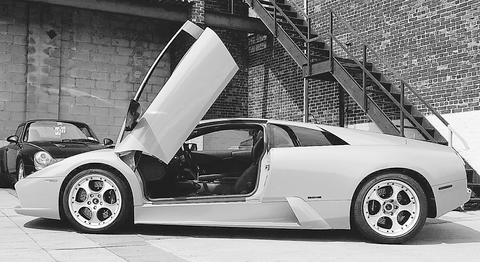There's not a lot of room for luggage in the front trunk of a midengine Lamborghini Murcielago, possibly not enough for US$273,000 in cash, which is what the car costs, plus US$15,000 in gas-guzzler and luxury taxes. But this extreme streamliner with its 575HP engine and race-car soundtrack is a veritable freight train when it comes to hauling psychological baggage.
New Yorkers either loved me or hated me when I pulled up in this intergalactic Italian groundship. I have to admit I had a few mixed feelings about myself, as well.
In times of terrorism and world tension, how relevant is an electric-yellow, 320kph, all-wheel-drive doorstop like the Murcielago (pronounced mur-SEE-a-lago)? Hard to say. A steady procession of pedestrians approached the car, either to pay tribute to my racy good taste or to snigger openly about whatever physical or emotional inadequacies would compel a middle-aged man -- namely me -- to choose such a conspicuous form of transport.

PHOTO: NY TIMES
This is the price you pay for driving a fantasy machine that dazzles onlookers with its shape and sound. With doors that scissor upward rather than open outward, and huge electrically controlled air scoops that silently emerge from the pronounced haunches, the Murcielago announces its owner's wealth, and ego, with an atomic bullhorn.
Surprisingly for something so low -- the roof is just 44 inches from the pavement -- this is a pretty easy exotic car to drive around town. It doesn't overheat. It is hard to stall. You can raise the body a bit to traverse bumps and avert driveway scrapes.
Founded in Sant'Agata, Italy, in 1963 by an industrialist, Ferruccio Lamborghini, to do battle with the road cars of Enzo Ferrari, the company has been financially troubled for much of its existence, and has defied the attempts of many owners to set the ship right. Uncertain demand for exotic automobiles, labor turmoil and the cars themselves -- plagued by finicky electrical systems, complex mechanicals and supernatural tendencies to rust -- made Lamborghini an evolving encyclopedia of all that was wrong with the business of Italian handbuilt cars.

PHOTO: NY TIMES
After the Volkswagen Group bought Lamborghini in 1998 (and put it under the wing of Audi) came the grim task of turning the tiny company around. The results -- seen for the first time on the 2002 Murcielago -- could have been predicted by students of the cool, efficient VW operation. Rough edges have been smoothed, function has been enhanced and a little emotion has been lost. But not too much.
Cool running
My test car's electrical components and air-conditioning functioned flawlessly in downtown traffic. The switches looked as though they had come straight from the VW-Audi parts bin, perhaps the best mass-market parts bin there is.
Despite the German meddling, the irrepressible spirit of an Italian hot-rod somehow survives, thanks in large measure to the intoxicating ways of the high-revving, free-breathing V12 engine, situated directly behind the two manually adjusted seats. It is the most potent power plant Lamborghini has ever put in a street machine.
The sense of Teutonic precision overlaid on raw Italian emotion carries over to the Murcielago's finely fettled if still outrageously extroverted design. You can see out of the mail-slot rear window, in contrast to some of the car's predecessors, though you still have no idea where the front ends, so sharply does it slope away from your field of vision. The precise location of the nether reaches is a similar mystery to the driver, so claiming a space on city streets is a high-risk endeavor, even for a Olympian parallel-parker like myself. Happily, the steering is light and the clutch operation is unexpectedly delicate, making it simple to take advantage of the six forward gears.
Practically speaking, three grocery bags in the nose is the cargo limit if the passenger seat is filled, but those groceries would make it home in a hurry. Violent acceleration is available on demand.
The Murcielago may be the diametric opposite of an SUV, but it, too, has all-wheel drive. Together with electronic traction control, it helps put a corrupting amount of absolute power to the ground with a minimum of antisocial wheel spin.
Speed
The Murcielago is one of the fastest production cars ever, reaching 97kph from a stop in 3.6 seconds. Yet the Lamborghini can dawdle around town, calling no attention to itself other than that which comes naturally to a machine that is radically shaped and radioactively yellow.
Fuel economy is not a talking point for Lamborghini salesmen; the car slurps a gallon of premium every 19km, and more in town. In other words, it gets even more appalling mileage than a Land Cruiser or a Suburban in a package that is even more frivolous and unnecessary.
New Yorkers are clearly divided about automotive frivolity, and they urgently want to share their views. People assume that a fellow extracting himself through the upraised door of an exotic car that pops and fizzes as it rolls up at hip level wants to hear -- nay, deserves to hear -- from them.
Two proximate encounters typified the currents of thought. A too-cool-for-school hipster crowd laughed and pointed derisively as I pulled up to the Mercury Lounge on the Lower East Side of Manhattan. A block away, workers from Katz's Delicatessen, out on a cigarette break, gave me a round of applause.
Women seemed less appreciative than men. While crossing at a light in TriBeCa, some black-clad ladies made it clear that they do not do like Lamborghinis. This is a paradox of the Murcielago experience: Young dudes think it will get them dates, but it turns out that the demographic group most attracted by the car are other young men who think it will get them dates.
As befits a machine so lacking in subtlety, Lamborghinis have long taken their names from the realm of bullfighting. While Murcielago means bat in Spanish, it was also the name of a 19th-century fighting bull whose life was spared in honor of his indefatigable courage and spirit.
Murcielago owners must not themselves lack courage or spirit; they will need both qualities to drive their cars in public. A self-selecting bunch, those who need 575HP and have 300 grand burning holes in their pockets need not look anywhere else.

To many, Tatu City on the outskirts of Nairobi looks like a success. The first city entirely built by a private company to be operational in east Africa, with about 25,000 people living and working there, it accounts for about two-thirds of all foreign investment in Kenya. Its low-tax status has attracted more than 100 businesses including Heineken, coffee brand Dormans, and the biggest call-center and cold-chain transport firms in the region. However, to some local politicians, Tatu City has looked more like a target for extortion. A parade of governors have demanded land worth millions of dollars in exchange

Hong Kong authorities ramped up sales of the local dollar as the greenback’s slide threatened the foreign-exchange peg. The Hong Kong Monetary Authority (HKMA) sold a record HK$60.5 billion (US$7.8 billion) of the city’s currency, according to an alert sent on its Bloomberg page yesterday in Asia, after it tested the upper end of its trading band. That added to the HK$56.1 billion of sales versus the greenback since Friday. The rapid intervention signals efforts from the city’s authorities to limit the local currency’s moves within its HK$7.75 to HK$7.85 per US dollar trading band. Heavy sales of the local dollar by

Taiwan Semiconductor Manufacturing Co’s (TSMC, 台積電) revenue jumped 48 percent last month, underscoring how electronics firms scrambled to acquire essential components before global tariffs took effect. The main chipmaker for Apple Inc and Nvidia Corp reported monthly sales of NT$349.6 billion (US$11.6 billion). That compares with the average analysts’ estimate for a 38 percent rise in second-quarter revenue. US President Donald Trump’s trade war is prompting economists to retool GDP forecasts worldwide, casting doubt over the outlook for everything from iPhone demand to computing and datacenter construction. However, TSMC — a barometer for global tech spending given its central role in the

The Financial Supervisory Commission (FSC) yesterday met with some of the nation’s largest insurance companies as a skyrocketing New Taiwan dollar piles pressure on their hundreds of billions of dollars in US bond investments. The commission has asked some life insurance firms, among the biggest Asian holders of US debt, to discuss how the rapidly strengthening NT dollar has impacted their operations, people familiar with the matter said. The meeting took place as the NT dollar jumped as much as 5 percent yesterday, its biggest intraday gain in more than three decades. The local currency surged as exporters rushed to